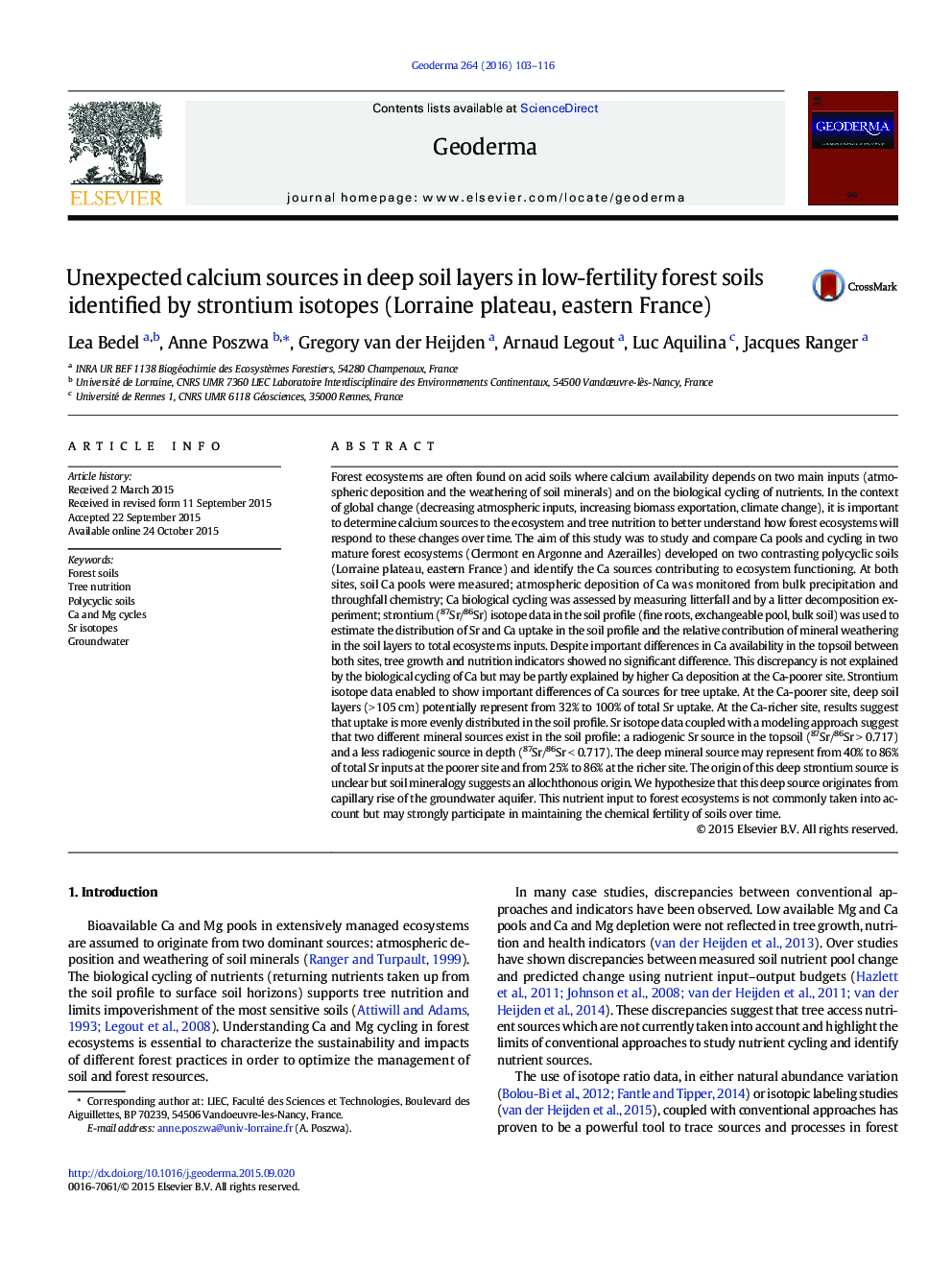| کد مقاله | کد نشریه | سال انتشار | مقاله انگلیسی | نسخه تمام متن |
|---|---|---|---|---|
| 4573087 | 1332418 | 2016 | 14 صفحه PDF | دانلود رایگان |
• Sr isotopes were used to trace Ca sources and cycles in two forest polycyclic soils.
• Different available Ca pools were not reflected in tree growth and nutrition indicators.
• Modeling and isotope data showed Sr uptake from deep soil layers.
• Modeling and isotope data suggest two different sources of mineral weathering.
• Groundwater aquifers may represent an important input to forest ecosystems.
Forest ecosystems are often found on acid soils where calcium availability depends on two main inputs (atmospheric deposition and the weathering of soil minerals) and on the biological cycling of nutrients. In the context of global change (decreasing atmospheric inputs, increasing biomass exportation, climate change), it is important to determine calcium sources to the ecosystem and tree nutrition to better understand how forest ecosystems will respond to these changes over time. The aim of this study was to study and compare Ca pools and cycling in two mature forest ecosystems (Clermont en Argonne and Azerailles) developed on two contrasting polycyclic soils (Lorraine plateau, eastern France) and identify the Ca sources contributing to ecosystem functioning. At both sites, soil Ca pools were measured; atmospheric deposition of Ca was monitored from bulk precipitation and throughfall chemistry; Ca biological cycling was assessed by measuring litterfall and by a litter decomposition experiment; strontium (87Sr/86Sr) isotope data in the soil profile (fine roots, exchangeable pool, bulk soil) was used to estimate the distribution of Sr and Ca uptake in the soil profile and the relative contribution of mineral weathering in the soil layers to total ecosystems inputs. Despite important differences in Ca availability in the topsoil between both sites, tree growth and nutrition indicators showed no significant difference. This discrepancy is not explained by the biological cycling of Ca but may be partly explained by higher Ca deposition at the Ca-poorer site. Strontium isotope data enabled to show important differences of Ca sources for tree uptake. At the Ca-poorer site, deep soil layers (> 105 cm) potentially represent from 32% to 100% of total Sr uptake. At the Ca-richer site, results suggest that uptake is more evenly distributed in the soil profile. Sr isotope data coupled with a modeling approach suggest that two different mineral sources exist in the soil profile: a radiogenic Sr source in the topsoil (87Sr/86Sr > 0.717) and a less radiogenic source in depth (87Sr/86Sr < 0.717). The deep mineral source may represent from 40% to 86% of total Sr inputs at the poorer site and from 25% to 86% at the richer site. The origin of this deep strontium source is unclear but soil mineralogy suggests an allochthonous origin. We hypothesize that this deep source originates from capillary rise of the groundwater aquifer. This nutrient input to forest ecosystems is not commonly taken into account but may strongly participate in maintaining the chemical fertility of soils over time.
Journal: Geoderma - Volume 264, Part A, 15 February 2016, Pages 103–116
